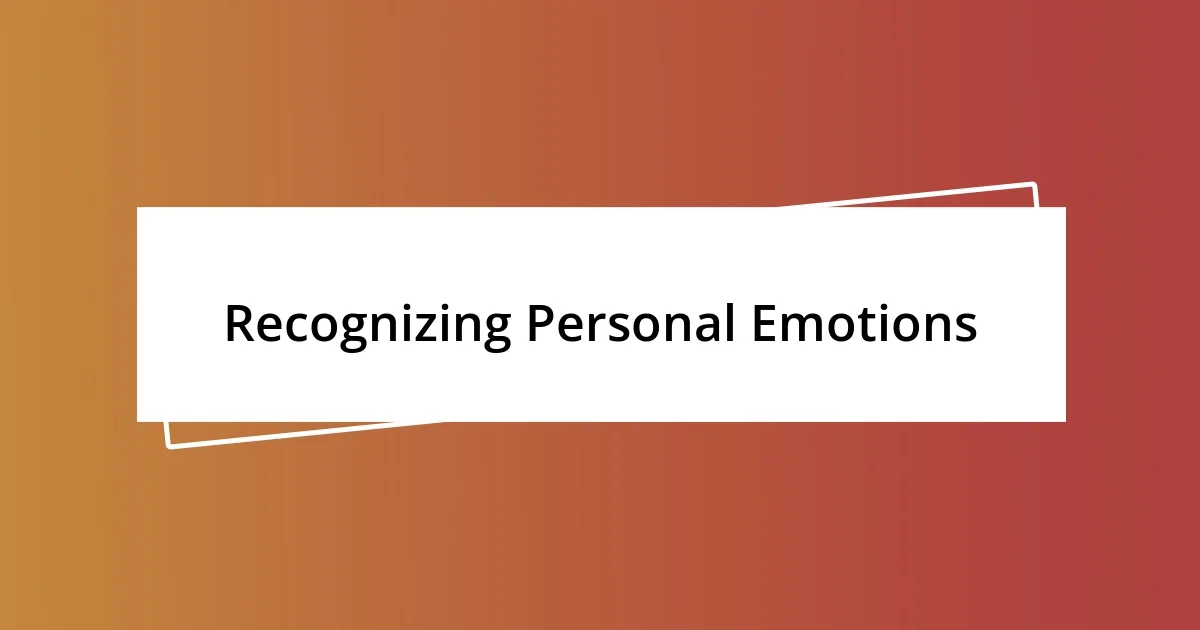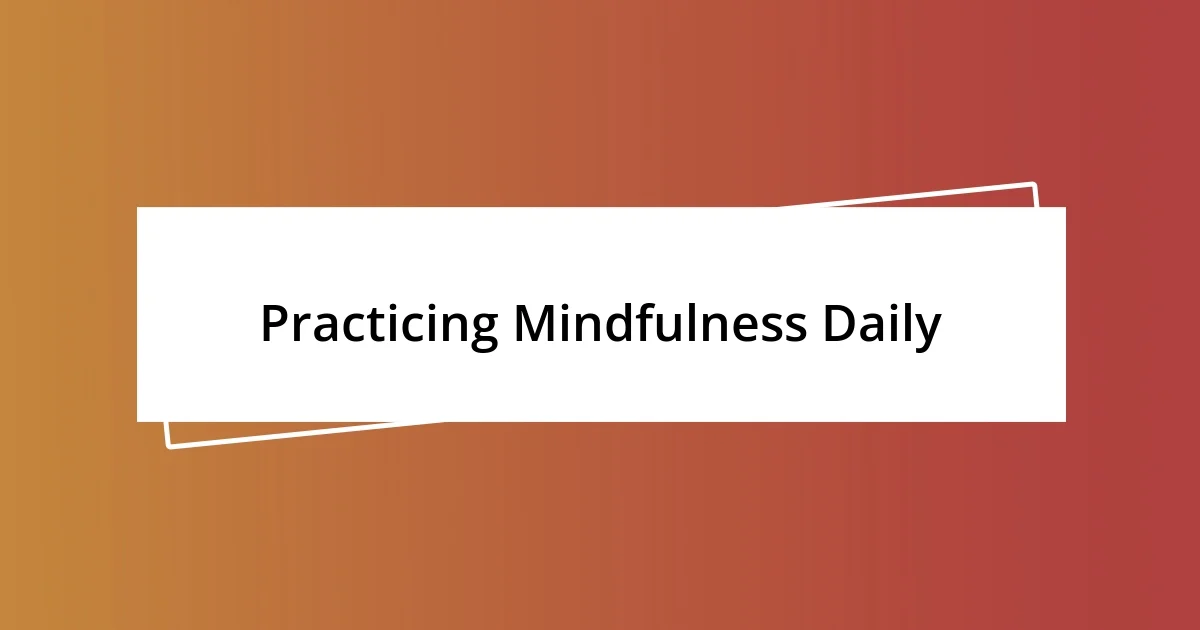Key takeaways:
- Emotional awareness involves recognizing and understanding one’s own emotions and those of others, enhancing self-understanding and relationships.
- Journaling and mindfulness meditation are effective techniques for reflecting on emotions, helping to identify patterns and gain clarity without judgment.
- Seeking feedback from others and practicing empathy are crucial for personal growth, as they provide insights and strengthen emotional connections.

Understanding Emotional Awareness
Emotional awareness is essentially the ability to recognize and understand our own emotions as well as those of others. I remember a time when I was feeling particularly overwhelmed but didn’t quite know why. It took a moment of stillness to realize that I was not just stressed but also feeling a sense of loss for opportunities missed.
As I began to develop this awareness, I learned to ask myself guiding questions like, “What exactly am I feeling right now?” This practice reveals layers of emotion I hadn’t noticed before. It’s fascinating how identifying an emotion can unravel a whole web of thoughts and beliefs tied to it.
Engaging with emotions openly has transformed my relationships. Once, I noticed a friend was unusually quiet, and instead of brushing it off, I asked if everything was okay, tapping into my own understanding of emotional cues. This simple conversation deepened our bond and allowed me to connect with my own vulnerabilities, demonstrating how emotional awareness can enhance not only self-understanding but also empathy toward others.

Recognizing Personal Emotions
Recognizing my personal emotions has been a journey filled with eye-opening moments. One day, while sitting at my desk, I felt a tightness in my chest that I couldn’t shake. I paused and asked myself what I was really experiencing beyond the physical sensation. This reflection led me to realize I was feeling anxious about a looming deadline but also a little embarrassed for needing more time than I had initially planned. This simple act of recognition unveiled not just the anxiety but the deeper layers of self-judgment that were affecting my emotional state.
To effectively recognize personal emotions, I found it helpful to jot down my feelings throughout the day. Here are some key questions I often consider:
- What physical sensations am I experiencing?
- Are there specific thoughts that recur when I feel this way?
- How does this emotion relate to my past experiences?
- In what ways do I express (or suppress) this feeling?
- What do I need right now to process this emotion?
By reflecting on these questions, I gradually became more attuned to the subtleties of my emotional landscape. Through practice, I’ve learned that recognizing my emotions isn’t just about labeling them; it’s about understanding their roots and ultimately nurturing my inner self with compassion.

Techniques for Emotional Reflection
One technique that has significantly helped me in my journey of emotional reflection is journaling. I started by dedicating a few minutes each evening to write about my day and how I felt during various moments. Initially, it felt like a chore, but as I persisted, I noticed how writing allowed me to clarify my emotions. I could see patterns emerge, like the way I often felt anxious before social events. Recognizing this pattern helped me prepare mentally, turning an anxious anticipation into a manageable experience.
Mindfulness meditation has also played a pivotal role in fostering emotional awareness. I remember the first time I tried sitting quietly and focusing on my breath. At first, my mind raced through a list of worries, but gradually, I learned to acknowledge those thoughts without judgment. This allowed me to experience emotions in real-time instead of getting swept up in them. When sadness crept in, I learned to sit with it, experiencing its depth instead of pushing it away, which cultivated a sense of acceptance and understanding within myself.
Lastly, engaging in open conversations with trusted friends has been a profound technique for emotional reflection. I found that discussing my feelings openly not only lightened the emotional load but also offered new perspectives on what I was experiencing. For instance, after sharing my feelings of inadequacy regarding my career path, a friend revealed she had similar fears, changing my view about my struggles. It became clear that navigating emotions doesn’t have to be a solitary journey; there’s immense value in connecting with others, learning, and healing together.
| Technique | Description |
|---|---|
| Journaling | A daily practice of writing about emotions and experiences to identify patterns and foster clarity. |
| Mindfulness Meditation | A practice of focusing on the present moment to recognize and accept emotions without judgment. |
| Open Conversations | Sharing feelings with friends or trusted individuals to gain new insights and strengthen emotional connections. |

Practicing Mindfulness Daily
Practicing mindfulness daily has become the foundation for my emotional awareness journey. I started small, dedicating just five minutes each morning to sit quietly and focus on my breath. At first, it felt challenging—my mind would wander to the day ahead or unfinished tasks. But over time, I learned to gently redirect my thoughts back to the present moment. This practice became a daily ritual that anchored my emotions and helped me gain clarity.
After a few weeks, I noticed something remarkable. I began to approach my emotions with curiosity rather than judgment. One day, while practicing mindfulness, a wave of sadness engulfed me. Instead of resisting it, I took a deep breath and asked myself, “What’s beneath this sadness?” I discovered it was tied to feelings of loneliness that I hadn’t fully acknowledged. This insight opened a door to understanding and processing my emotions instead of pushing them away.
Integrating mindfulness into my routine has also encouraged me to observe my emotional triggers. For example, after a stressful meeting, rather than defaulting to frustration, I now pause to assess why I felt that way. What conditions contributed? This approach allows me to respond more thoughtfully rather than reactively, leading to healthier interactions. Isn’t it fascinating how just a few minutes of mindfulness can shift your entire perspective on your emotions?

Journaling for Emotional Insight
Journaling has been a transformative part of my emotional exploration. I remember one evening, feeling particularly overwhelmed, I sat down with my notebook and simply began to write. I jotted down everything from minor annoyances to profound fears. As the words flowed, I was struck by how articulating these emotions not only lessened their weight but also provided clarity. It was as if the act of writing untangled the knots of my feelings, letting me see them for what they truly were.
One method I often employed was listing my emotions at the end of the day. This simple exercise allowed me to pinpoint specific feelings I had experienced throughout the day, like joy, anxiety, or frustration. By naming them, I felt empowered, almost like I was taking ownership of my emotional landscape. For instance, I distinctly remember realizing how often anger cropped up in response to certain interactions. This revelation sparked a deeper investigation into why I reacted that way, paving the way for personal growth.
There were times when I reflected on past entries, which was both enlightening and humbling. I could trace my emotional evolution over months. I often asked myself, “Why was I so upset about that situation last month?” Revisiting these insights revealed patterns in my emotional responses, helping me craft strategies for dealing with similar feelings moving forward. Doesn’t it make you wonder how much we can learn from our own words? Journaling not only creates a safe space for expression but also serves as a valuable tool for ongoing self-discovery.

Seeking Feedback from Others
Seeking feedback from others has been a crucial aspect of my emotional awareness journey. I remember asking a close friend for their perspective on my reactions during a recent conflict. Their honesty, while initially difficult to hear, provided me with insights I had been blind to; I realized how often I had been dismissive during our discussions. Have you ever experienced that moment when someone helps you see a part of yourself you hadn’t acknowledged?
After that conversation, I began to seek feedback more intentionally. I’d regularly ask colleagues for their input after group discussions, prompting them to share how my words or reactions affected the dynamic. One memorable instance was during a team brainstorming session where I recognized my tendency to dominate conversations. They mentioned feeling stifled, and in that moment, I understood the importance of balancing my enthusiasm with inclusivity. How powerful it is to gain that outside perspective, isn’t it?
Incorporating feedback from others not only honed my emotional awareness but also deepened my relationships. I learned that vulnerability plays a key role in this process. The more open I was to receiving constructive criticism, the more trust I built, both with myself and others. Have you ever felt the warmth that comes from being truly seen and understood? For me, those candid conversations became a catalyst for personal growth and emotional insight.

Developing Empathy Skills
Developing empathy skills has been an eye-opening part of my journey toward emotional awareness. One evening, I found myself sitting across from a friend who seemed upset. Instead of brushing it off, I asked what was bothering them. As they opened up, I found myself not just listening but really feeling their emotions. I could sense the weight of their unhappiness; it was a revelation for me. Have you ever stopped to think about how much your presence can impact someone else’s experience?
To deepen my empathy, I started putting myself in others’ shoes more often. I recall a moment when a colleague faced a challenging project. Instead of letting my own frustrations surface, I focused on supporting them by asking how they felt about it. This shift not only strengthened our team but also invited me to forge deeper connections. It’s fascinating how understanding someone else’s perspective can sometimes reveal layers of your own emotional responses. Have you thought about how adjusting your viewpoint can affect your interactions?
Practicing empathy became a daily exercise. Whether I was observing a stranger’s struggle or listening to a family member’s story, I actively sought to connect emotionally. I remember a day in a coffee shop, where I noticed a barista’s tired smile. I took a moment to share a genuine compliment, acknowledging their hard work. That small gesture opened up a delightful conversation that brightened both our days. Isn’t it incredible how a little empathy can transform a simple interaction into a meaningful exchange? Each of these experiences taught me that empathy isn’t just about feeling; it’s about action and connection.













